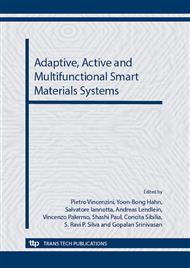p.291
p.297
p.302
p.307
p.313
p.319
p.325
p.333
p.343
Tailored One-Way and Two-Way Shape Memory Response of Poly(ε-Caprolactone)-Based Systems for Biomedical Applications
Abstract:
A series of crosslinked poly(ε-caprolactone) (PCL) materials were obtained starting from linear, three- and four-arm star PCL functionalized with methacrylate end-groups, allowing to tune the melting temperature (Tm) on a range between 36 and 55°C. After deforming the specimens at 50% above Tm, the materials are seen to fully restore their original shape by heating them on a narrow region close to Tm; further, when the shape memory effect is triggered under fixed strain conditions, the materials are able to exert stress on a range between 0.2 and 7 MPa. The materials also display two-way shape memory features, reversibly moving between two shapes when cooled and heated under a fixed load. Finally, to investigate the application of the PCL materials as self-expandable stents, one-way shape memory experiments are currently carried out on tubular specimens.
Info:
Periodical:
Pages:
313-318
Citation:
Online since:
September 2012
Keywords:
Price:
Сopyright:
© 2013 Trans Tech Publications Ltd. All Rights Reserved
Share:
Citation:


